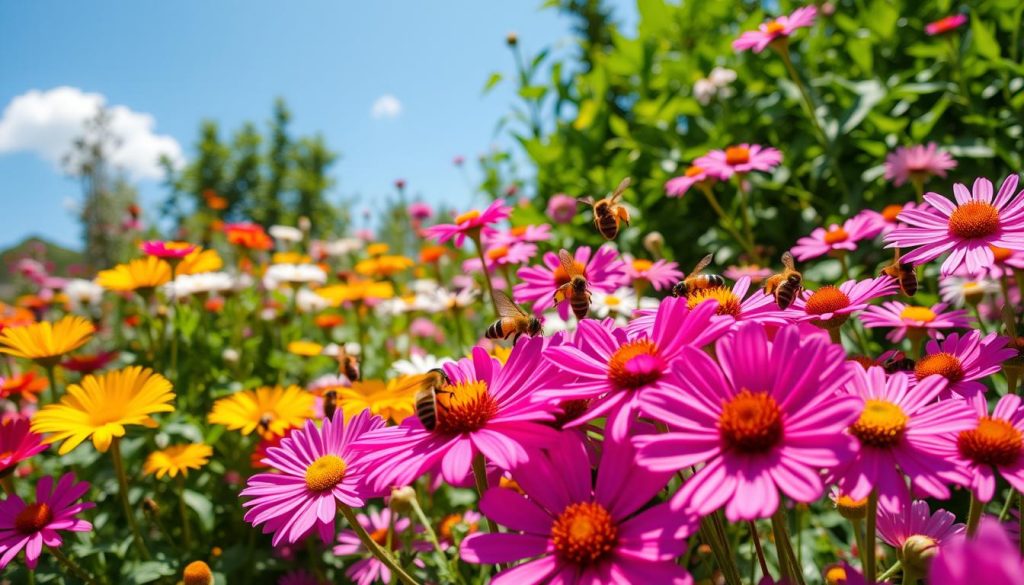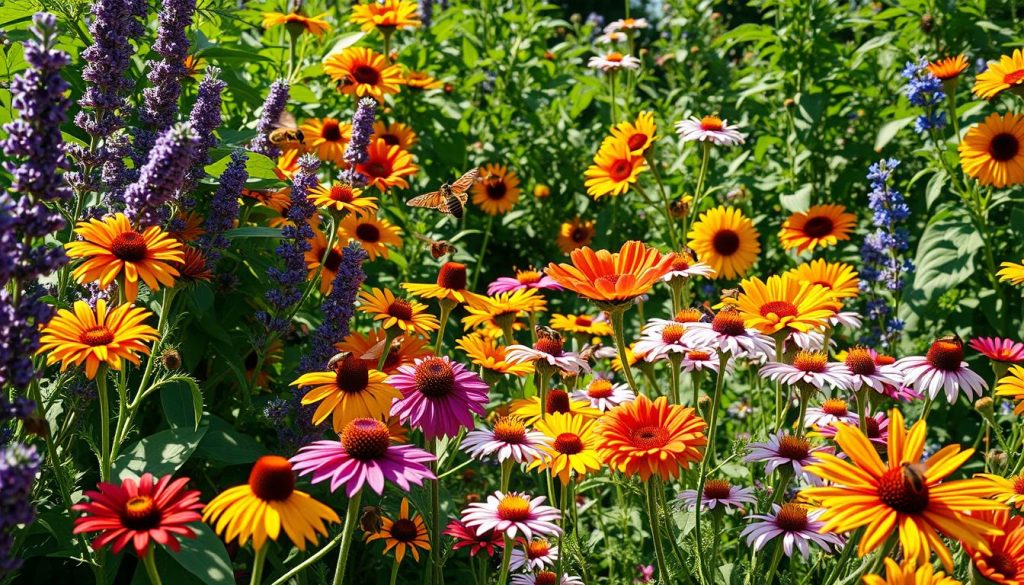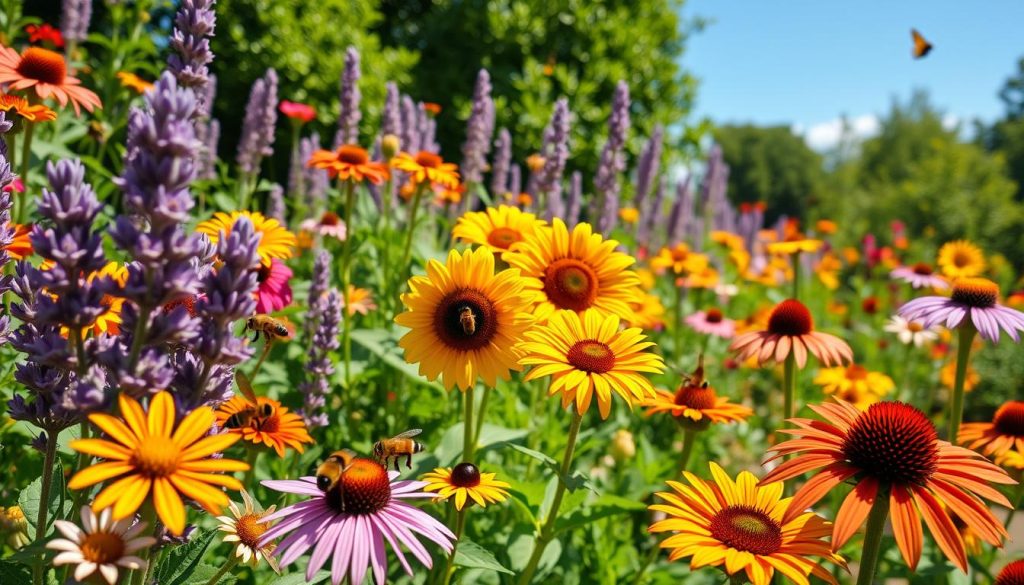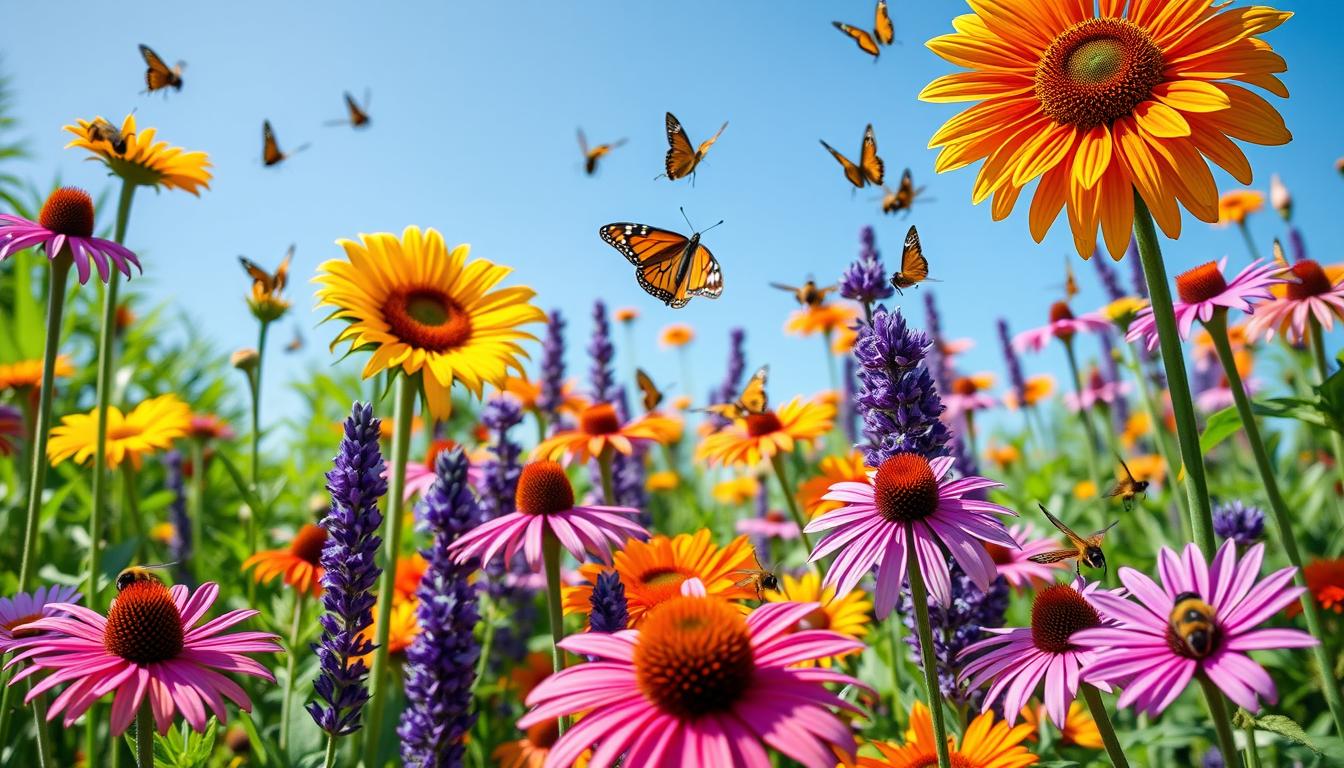I’m excited to share my knowledge on growing the best flowers for pollinators. These flowers are key to a pollinator-friendly garden. They attract bees, butterflies, and other pollinators, giving them the nectar and pollen they need.
By choosing the right flowers, you can make a big difference in your garden. This guide will help you pick the best flowers and create a welcoming space for pollinators. It’s perfect for both seasoned gardeners and beginners.
In this guide, I’ll share my expertise on growing the best flowers for pollinators. You’ll learn about pollinator-friendly flowers that attract bees, butterflies, and other beneficial insects. Follow my tips to create a stunning and thriving garden that supports these vital creatures.
Understanding the Importance of Pollinators
Pollinators like bees, butterflies, and hummingbirds are key to our ecosystem. They help plants make fruits, veggies, and seeds. By choosing the right flowers, we can attract these important creatures to our gardens.
To make a garden friendly for pollinators, we need to know their value. Here are some important points:
- Pollinators pollinate over 75% of the world’s crops.
- Without them, our food supply would drop, leading to less food for everyone.
- Planting the right flowers can draw these vital insects to our gardens.
What Are Pollinators?
Pollinators are insects, birds, and mammals that move pollen between plants. This lets plants make fruits, veggies, and seeds.

Why Pollinators Matter
Pollinators are crucial for our ecosystem’s health. They help keep our food supply and environment healthy. By supporting them, we ensure a sustainable future for our food and planet.
Selecting the Right Flowers for Pollinators
Creating a pollinator-friendly garden starts with the right flowers. As a gardener, I’ve found that picking the best flowers for pollinators is key. It’s important to know the difference between native and non-native flowers and what makes them good for pollinators.
For pollinators like bees and butterflies, nectar and pollen are vital. The best flowers for them have bright colors, strong scents, and unique shapes. By adding these flowers to my garden, I make it a welcoming place for pollinators.

- Rich nectar and pollen sources
- Bright colors and unique shapes
- Strong scents that attract pollinators
By focusing on these traits and choosing wisely, I can make my garden a haven for pollinators. This supports the local ecosystem and brings in many beneficial insects.
Top Flower Choices for Pollinators
Creating a pollinator-friendly garden starts with the right flowers. Choose a mix of wildflowers, perennials, and annuals. These flowers offer nectar and pollen, which are full of nutrients.
A Look at Wildflowers
Wildflowers are perfect for pollinators because they’re full of nectar and pollen. Black-eyed Susans, cosmos, and zinnias are great choices. They’re easy to grow and need little care, perfect for any gardener.
Perennials That Attract Pollinators
Perennials are also excellent for attracting pollinators. Coneflowers, bee balm, and lavender are popular picks. These flowers are tough and come back every year, offering a steady food source for pollinators.
Annuals to Consider for a Vibrant Garden
Annuals bring color and life to your garden while drawing in pollinators. Marigolds, sunflowers, and daisies are great options. They’re simple to grow and fit well in many spots, making them ideal for all gardeners.
Here are some top flower species for pollinators:
- Black-eyed Susans
- Coneflowers
- Bee balm
- Lavender
- Marigolds
- Sunflowers
- Daisies

Timing Your Planting for Maximum Impact
Creating a pollinator-friendly garden starts with the right timing. It’s key to have flowers that bloom at different times. This way, your garden will always be a hit with pollinators.
Seasonal Considerations
Think about the seasons in your area. Plant flowers that do well in each season. For example, crocuses and daffodils are great in spring because they’re full of nectar and pollen.
In summer, sunflowers and zinnias are perfect. They draw in pollinators like bees and butterflies.
Flowering Times to Attract Pollinators
Choose flowers that bloom at various times to attract pollinators. Here’s a mix to consider:
- Spring-blooming flowers like tulips and hyacinths
- Summer-blooming flowers like black-eyed susans and cosmos
- Fall-blooming flowers like asters and sedum
By planting a variety of flowers, your garden will be a constant draw for pollinators. Make sure to pick the best flowers for pollinators. Also, include both native and non-native flowers to attract a wide range of pollinators.

Creating a Pollinator-Friendly Garden Design
To attract pollinators, your garden needs to be welcoming. A well-designed garden can really help. Think about the flowers you want to include.
A good garden design has flowers that bloom at different times. This gives pollinators a steady supply of nectar and pollen. Choose a mix of annuals and perennials like sunflowers, zinnias, and coneflowers.
Garden Layout Tips
Here are some tips for your garden layout:
- Choose a spot that gets full sun to partial shade, based on your flowers.
- Plant flowers in clusters to create a welcoming habitat.
- Use a mix of native and non-native flowers to attract many pollinators.
Incorporating Variety and Color
Using different colors and shapes can attract more pollinators. Bees like yellow, blue, and purple flowers. Butterflies prefer red, orange, and purple.
Using Layers and Heights for Diversity
Adding layers and heights makes your garden more diverse. Use groundcovers, shrubs, and trees for a layered look.
| Layer | Description |
|---|---|
| Groundcover | Low-growing plants that cover the soil, such as creeping thyme or sedum. |
| Shrub | Medium-sized plants that provide structure and habitat, such as lavender or rosemary. |
| Tree | Tall plants that provide shade and habitat, such as oak or willow. |
Best Practices for Caring for Your Pollinator Garden
To keep your pollinator garden healthy, follow some key care tips. Choose the best flowers and plants for pollinators. Also, make sure they have the right conditions to grow well.
Watering Techniques
Watering your garden plants right is very important. Too much water can harm them, while too little can make them weak. Find a good balance to keep your garden strong and vibrant.
Organic Pest Control Methods
To keep pests away from your flowers, use organic methods. You can introduce good bugs, use neem oil, or plant things together. These ways help protect your garden without harming pollinators.
Here are some tips for your pollinator garden:
- Use natural fertilizers for healthy plants
- Give pollinators water, like a shallow dish or birdbath
- Make your garden diverse with many plants to attract different pollinators
Supporting Pollinators Beyond Flowers
Flowers are key for attracting pollinators, but there’s more to do. To make your garden a true haven, add host plants for butterflies, native grasses, and water sources. These steps will draw and keep pollinators, making your garden a vital spot for them.
Native wildflowers, shrubs, and trees are great for pollinators. They offer nectar and pollen. Plants like coneflowers and black-eyed susans are perfect. Adding these to your garden welcomes pollinators.
Adding Host Plants for Butterflies
Butterflies need specific plants to lay eggs and for their young to eat. Milkweed is key for monarchs, and dill is for black swallowtails. Adding these plants supports butterflies and attracts them to your garden.
Creating Habitats with Native Grasses
Native grasses are homes for bees and butterflies. They also keep soil stable and prevent erosion. Little bluestem and big bluestem are good examples. They make your garden diverse and sustainable.
Providing Water Sources
Pollinators drink and cool down in water. Use a shallow dish or birdbath with fresh water and rocks or twigs. A pollinator-friendly pond with native plants and a shallow area is also a great idea.
By following these tips, you can make a garden that supports pollinators beyond flowers. Choose the best plants to attract and keep these vital creatures.
| Plant Type | Examples | Pollinators Attracted |
|---|---|---|
| Native Wildflowers | Coneflowers, Black-eyed Susans | Bees, Butterflies |
| Host Plants | Milkweed, Dill | Monarch Butterflies, Black Swallowtail Butterflies |
| Native Grasses | Little Bluestem, Big Bluestem | Bees, Butterflies |
Community Involvement in Pollinator Protection
Learning about pollinators shows us how important community help is. Together, we can make a big difference in protecting them. Joining local conservation efforts is a great way to start. They often host events to teach us about pollinator-friendly gardening.
Getting involved can mean many things. You could help out in community gardens, go to workshops, or volunteer with beekeepers. Sharing what we know helps others join in. For instance, we can teach people about the best flowers for pollinators like sunflowers and zinnias.
Engaging with Local Conservation Initiatives
- Participate in community garden projects
- Attend workshops on pollinator-friendly gardening
- Volunteer for local beekeeping organizations
Sharing Resources and Knowledge
Sharing our knowledge helps others help pollinators too. We can teach about planting flowers like coneflowers and black-eyed susans. Together, we can build a community that cares for these important pollinators.
| Flower | Pollinator Attraction |
|---|---|
| Sunflowers | High attraction for bees and butterflies |
| Zinnias | High attraction for butterflies and hummingbirds |
| Coneflowers | High attraction for bees and butterflies |
Tools and Resources to Aid Your Gardening
As a gardener, having the right tools and resources is key to a thriving pollinator-friendly garden. It’s vital to have the necessary equipment to plant and care for flowers that attract pollinators.
Start by investing in essential gardening tools like gloves, pruning shears, and a watering can. These tools will make it easier to plant and care for your flowers. This way, you can attract more pollinators to your garden.
Essential Gardening Tools
- Gloves to protect your hands while gardening
- Pruning shears to trim and shape your flowers
- Watering can to provide adequate water for your plants
Online Resources and Communities
There are many online resources and communities to help you learn more about gardening and attracting pollinators. Websites like the National Gardening Association and the Pollinator Partnership are great places to start.
Books to Enhance Your Garden Knowledge
For deeper insights into gardening and attracting pollinators, consider reading books like “The Pollinator Garden” and “Gardening for Butterflies and Pollinators”. These books offer valuable tips and advice for creating a thriving pollinator-friendly garden.
| Book Title | Author | Description |
|---|---|---|
| The Pollinator Garden | Emma Marris | A comprehensive guide to creating a pollinator-friendly garden |
| Gardening for Butterflies and Pollinators | Jane Hurwitz | A guide to gardening for butterflies and other pollinators |
Troubleshooting Common Gardening Issues
As a gardener, I’ve faced many common problems. These include pests and managing soil quality. It’s key to solve these issues to keep my pollinator garden healthy and vibrant.
Dealing with Pests
Dealing with pests is a big challenge in gardening. I use organic methods to control them. This way, I protect my pollinator flowers and keep my garden healthy.
Managing Soil Quality
Soil quality is vital for my pollinator flowers. I test my soil often to check its pH and nutrients. Then, I add organic fertilizers to make the soil perfect for my plants.
Recognizing and Addressing Plant Diseases
Plant diseases can harm my garden quickly. I watch my plants closely for any signs of disease. If I find a problem, I treat it with organic solutions or remove sick plants.
Being ready to solve common gardening issues helps me maintain a vibrant garden. This way, my pollinator flowers and plants stay healthy and strong.
Celebrating the Beauty of Your Pollinator Garden
After working hard on your pollinator garden, it’s time to relax and enjoy. Look at the colorful flowers and the busy pollinators they draw.
Enjoying Pollinator Sightings
Watch for the many pollinators that will visit your garden. Admire the butterflies, bees, and hummingbirds as they move from flower to flower. These moments with nature are truly special.
Sharing Your Garden Journey
Share your garden with friends, family, and your community. Let them see the beauty of your garden. Post about your garden on social media to inspire others.
Hosting Pollinator Events
Host events or workshops in your garden to teach about pollinators. Invite experts to talk about their importance. These events can bring people together and help them help pollinators.
Enjoying your pollinator garden shows you care about these important creatures. Your garden is not just beautiful; it’s also helping the local ecosystem. Keep up the good work and inspire others to do the same.

